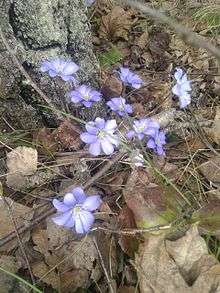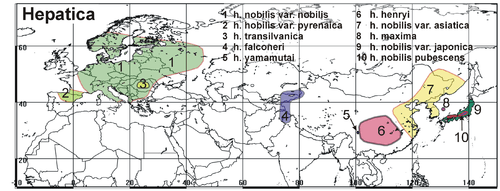Hepatica
Hepatica (hepatica,[1] liverleaf,[2] or liverwort)[3] is a genus of herbaceous perennials in the buttercup family, native to central and northern Europe, Asia and eastern North America. Some botanists include Hepatica within a wider interpretation of Anemone.[4][5]
| Hepatica | |
|---|---|
| Hepatica nobilis | |
| Scientific classification | |
| Kingdom: | Plantae |
| Clade: | Tracheophytes |
| Clade: | Angiosperms |
| Clade: | Eudicots |
| Order: | Ranunculales |
| Family: | Ranunculaceae |
| Subfamily: | Ranunculoideae |
| Tribe: | Anemoneae |
| Genus: | Hepatica Mill. |
| Species | |
|
See text | |

Etymology
The word hepatica derives from the Greek ἡπατικός hēpatikós, from ἧπαρ hêpar 'liver', because the three-lobed leaf was thought to resemble the human liver.[6]
Description
Bisexual flowers with pink, purple, blue, or white sepals and three green bracts appear singly on hairy stems from late winter to spring. Butterflies, moths, bees, flies and beetles are known pollinators.
The leaves are basal, leathery, and usually three-lobed, remaining over winter.
Cultivation
Hepatica cultivation has been popular in Japan since the 18th century (mid-Edo period), where flowers with doubled petals and a range of colour patterns have been developed.[7]
Noted for its tolerance of alkaline limestone-derived soils, Hepatica may grow in a wide range of conditions; it can be found either in deeply shaded deciduous (especially beech) woodland and scrub or grassland in full sun. Hepatica will also grow in both sandy and clay-rich substrates, being associated with limestone. Moist soil and winter snowfall are required; Hepatica is tolerant of winter snow cover, but less so of dry frost.
Propagation
Propagation is done by seeds or by dividing vigorous clumps in spring. However, seedlings take several years to reach bloom size, and divided plants are slow to thicken.
Herbalism
Hepatica is named from its leaves, which, like the human liver (Greek hepar), have three lobes. It was once used as a medicinal herb. Owing to the doctrine of signatures, the plant was once thought to be an effective treatment for liver disorders. Although poisonous in large doses, the leaves and flowers may be used as an astringent, as a demulcent for slow-healing injuries, and as a diuretic.[4]
Species


The known hepatica species can be divided into two series with respect to the leaf shape. The leaves of the series Triloba Ulbr.[8] Tamura:[9] are three-lobed with an smooth leaf edge. The series Angulosa (Ulbr.)[8] Tamura[9] are three- to five-lobed and leaf margin is mostly serrated. Between one and ten species of Hepatica are recognised, with some of the taxa more often treated as varieties:
Series with smooth leaf edge (Triloba)
- Hepatica nobilis = common hepatica[10] As sites, light beech and oak forests with calcareous, clay-rich soils are preferred. In the Alps it climbs to elevations of 2200 meters.
- Europe
- Hepatica nobilis var. nobilis = European Hepatica — Scandinavia to central Italy and Baltic to Balkan
- Hepatica nobilis var. pyrenaica = Hepatica pyrenaica — Pyrenees and mountains of northern Spain
- Asia
- Hepatica nobilis var. japonica = Hepatica japonica, synonym of Anemone hepatica var. japonica (Nakai) Ohwi[10] — Japan: main Island of Honshu, Shikoku, north of Kyushu island.
- Hepatica nobilis var. pubescens = Hepatica pubescens, synonym of Anemone hepatica var. japonica (Nakai) Ohwi[10] — Japan central Island of Honshu up to 1050 m.
- Hepatica asiatica (Nakai) — China: central and eastern, Korea, coastal region of the Far East of Russia; Forests and grassy slopes from 700 to 1100 m.
- Hepatica maxima (Nakai) — South Korea (endemic to Ulleung-do island)
- Hepatica insularis (Nakai) — South Korea
Series with crenated leaves (Angulosa)
- Europe
- Hepatica transsilvanica = Anemone transsilvanica (Fuss) Heuff.[10] — Romania (Carpathian Mountains, Transylvania)
- Asia
- Hepatica falconeri ((Thomson) Juz.) — Mountain forests of Central Asia; India: Northwest Himalayas (Himachal Pradesh, Jammu and Kashmir); Northwest China (Tienshan); Kyrgyzstan and Tajikistan Pamir-Alai); North Pakistan, Kazakhstan (North Tienshan) on heights up to 3100 m.
- Hepatica henryi (Oliv. (Steward))[18] — China (Central to West)(provinces Hubei, Hunan, Szechuan, Shaanxi at 1300-2000m.
- Hepatica yamatutai (Nakai)[19] — Western China (Sichuan), 800-2000m, endemic to a small area at mount Emei Shan; evergreen forests with high rainfall, related to H. henryi


See also
Michael Alexander Commichau: Hepatica: Aktueller Überblick über die Gattung. Eigenverlag, Suhl, ergänzte Auflage. 2007/2012. (http://hepatica-privat.de/Data/Hepatica.pdf)
References
- Gleason, H.A. 1952. The new Britton and Brown Illustrated flora of the Northeastern United States and adjacent Canada. Volume 2: The chloripetalous Dicotyledoneae. Hafner Press, New York.
- Bailey, L.H.; Bailey, E.Z.; the staff of the Liberty Hyde Bailey Hortorium. 1976. Hortus third: A concise dictionary of plants cultivated in the United States and Canada. Macmillan, New York.
- Webster's Third International Dictionary
- John Uri Lloyd; Curtis G. Lloyd (1884–1887). "Drugs and medicines of North America: Hepatica".
- Sara B. Hoot; Anton A. Reznicek; Jeffrey D. Palmer (Jan–Mar 1994). "Phylogenetic Relationships in Anemone (Ranunculaceae) Based on Morphology and Chloroplast DNA". Systematic Botany. 19 (1): 169–200. doi:10.2307/2419720. JSTOR 2419720.
- Shorter Oxford English dictionary. United Kingdom: Oxford University Press. 2007. p. 3804. ISBN 0199206872.
- Jon Ardle (2000). "Layers of Complexity". The Garden. Royal Horticultural Society.
- Ulbrich, O.E.: Über die systematische Gliederung und geographische Verbreitung der Gattung Anemone L. Bot. Jahrb. Syst. (1905) 37: 172 - 257, 38: 257 - 334.
- Tamura, M.: Morphology, ecology and phylogeny of the Ranunculaceae” VII. Science reports of South College, North College of Oska University, Japan 16:21-43, 1968.
- "The Plant List: A Working List of all Plant Species".
- Slattery, Britt E., Kathryn Reshetiloff, and Susan M. Zwicker (2003). "Hepatica nobilis var. obtusa". Native Plants for Wildlife Habitat and Conservation Landscaping: Chesapeake Bay Watershed.CS1 maint: multiple names: authors list (link)
- "Taxonomic Serial No.: 528379". Integrated Taxonomic Information System.
- "Anemone acutiloba (de Candolle) G. Lawson". Flora of North America.
- Alan S. Weakley (April 2008). "Flora of the Carolinas, Virginia, and Georgia, and Surrounding Areas".
- Slattery, Britt E., Kathryn Reshetiloff, and Susan M. Zwicker (2003). "Hepatica nobilis var. acuta". Native Plants for Wildlife Habitat and Conservation Landscaping: Chesapeake Bay Watershed.CS1 maint: multiple names: authors list (link)
- "Taxonomic Serial No.: 528378". Integrated Taxonomic Information System.
- "Anemone americana (de Candolle) H. Hara". Flora of North America.
- STEWARD, A.N.: in Rhodora 29: 53. 1927
- Peters, Jürgen: Das etwas andere Leberblümchen: Hepatica yamatutai Nakai in ‚Gartenbotanische Blätter‘ 5/2000 der Gartenbotanischen Vereinigung in Deutschland